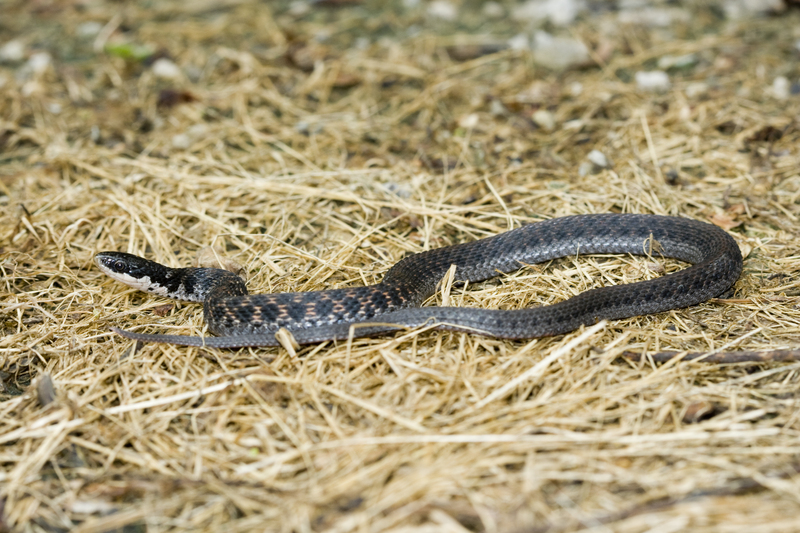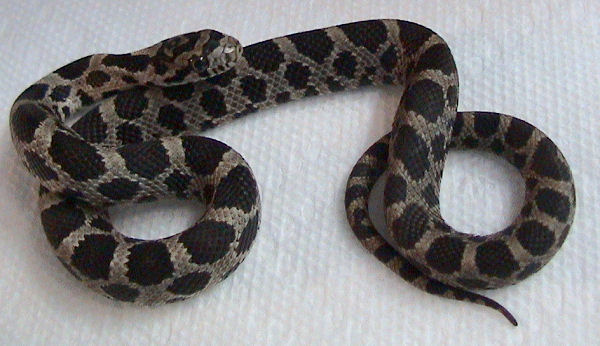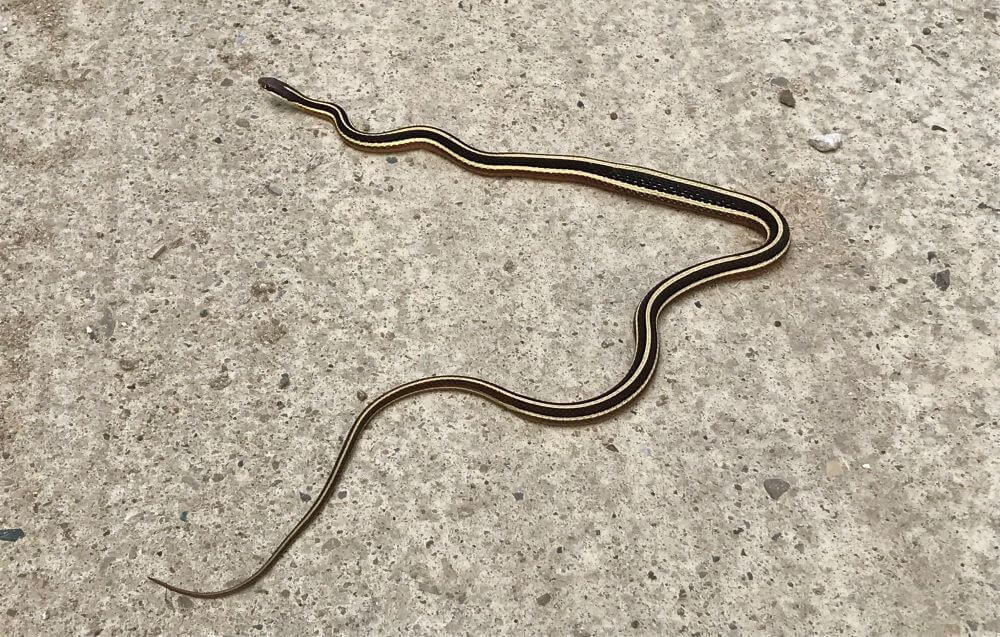Michigan is home to 19 snakes, some you may never encounter and others you may come across regularly. Most snakes will try and get away rather than be aggressive towards a human.
If you are wondering what snake you saw in your yard or when you were out in nature, continue reading to find out more.
Table of Contents
Are There Venomous Snakes In Michigan?
Eastern Massasauga Rattlesnakes are the only venomous snake you will encounter in Michigan.
They are shy and will avoid you wherever possible, spending their time in wetlands.
They are listed as a threatened species under the Endangered Species Act.
The good news is that bites from this snake are exceptionally rare in Michigan, but they can happen. If bitten seek medical attention right away.

Eastern Massasauga Rattlesnake Bites and Symptoms
The Eastern massasauga rattlesnakes venom is hemolytic, this means it breaks down red blood cells within your body.
Their venom is considered highly toxic, causing pain and burning in the bite area with swelling, discoloration, and bruising.
Other symptoms include weakness, vomiting, nausea, numbness in the face or limbs, sweating, blurred vision, problems breathing, and excessive salivation.
If bitten, get away from the snake immediately, don’t try and catch it, but try and remember the snake’s color and size, which can help the medical team ensure they provide you with the right anti-venom.
What To Do If Bitten By an Eastern Massasauga Rattlesnake
- Remove jewelry and tight-fitting clothes as soon as you can before swelling starts
- Do not raise the bite area above your heart, this increases the risk of venom reaching your heart quickly
- Stay still, movement increases blood flow. Increased blood flow helps the venom circulate through your bloodstream faster
- If the bite area is bleeding, let it bleed, which can release some of the venoms
- Do not wash the bite area
- Place a clean bandage on the wound
- Remain as calm as possible, anxiety can increase your heart rate
- Do not try and suck out the venom
- Do not use a tourniquet
- Do not apply ice or water to the bite site
- If you start going into shock, keep warm, lie on your back and raise your feet
- Get to a hospital as quickly as possible.
19 Snakes In Michigan
The 19 snakes you may encounter in Michigan include:
1. Kirtland’s snake

Scientific name: Clonophis kirtlandii.
Common name: Kirtland’s snake.
Length: 18 in (46 cm).
Kirtland’s snakes are slender, small snakes growing to around 18 inches (46cm).
They are gray to brown in color with large spots of black on their back and smaller spots on either side. The scales on the ventral side are red with a round black spot on each outer side.

This snake is common in southern Michigan, where it prefers forest, wetland, and grassland habitats, including marshes and swamps.
They are listed as endangered species in Michigan.
2. Blue Racer

Scientific name: Coluber constrictor foxii.
Common name: blue racer.
Length: up to 60 in (152 cm).
Blue Racers are only found in Michigan, Indiana, Ohio, Illinois, Iowa, and Wisconsin.
The blue racer is a beautiful snake with brilliant blue to dull gray lateral scales, creamy white ventral scales, and a dark gray dorsum. They have black masks on their face with large eyes.
Younger snakes have blotches that tend to fade when they reach three years.
The blue racer can grow to 152cm in length.
3. Northern Ring-necked Snake

Scientific name: Diadophis punctatus edwardsii.
Common name: Northern ringneck snake.
Length: 24 in (61 cm).
The Northern ring-necked snake can be black to a blue-gray in color with a yellow to orange ring that goes around the neck. Their underside matches the color of the ring with some dark patterns.
These snakes can grow to 2 feet (61cm) in length.
They prefer a wooded habitat, though they have been observed in open mountainous areas and on the edge of wetlands. They also seem to like moist basements that are humid.
4. Eastern Fox Snake

Scientific name: Pantherophis gloydi.
Common name: Eastern fox snake.
Length: 70 in (179 cm).
Eastern fox snakes are often encountered in marshy and flat areas, along with partially drained areas. They also enjoy rocky habitats and woodlands. They are ground dwellers and will very rarely be seen in a tree.
These snakes can grow to 179cm in length with a dorsal color that can be light brown to yellow with dark patches of chocolate or black. The head is usually red to brown.
Younger snakes are slightly lighter in color and darken with age.
They can be observed in farmlands, open woodlands, and prairies.
5. Western Fox Snake

Scientific name: Pantherophis vulpina.
Common name: Western fox snake.
Length: up to 6 feet (1.83 m).
Western fox snakes can grow to 6 feet (1.83 meters) in length.
They are light brown with dark brown spots and a yellow checker board patterning on their underside.
They are not venomous but will give off a musk if they feel threatened.
They enjoy a varied habitat, including farmlands, open woodlands, marshlands, pastures, and prairies.
6. Eastern Hog-nosed Snake

Scientific name: Heterodon platirhinos.
Common name: eastern hog-nosed snake, spreading adder.
Length: up to 46 in (116 cm).
The Eastern hog-nosed snake can grow to 46 inches (116cm) in length, the females are larger than the males.
They have an upturned snout, which they use to dig in the soil.
Their color varies from red to green, brown, black, gray, or orange, sometimes a combination of colors.
They may or may not have a checkered or blotchy pattern.
Their undersides are gray, cream, or yellow. The underside of their tail is lighter than the belly section.
They are not harmful to humans, though their saliva can cause localized swelling and discomfort.
If they feel threatened, they will flatten their neck and raise their head, similar to a cobra. They will also hiss and strike, but will not bite. If this does not work, they play a deal, emitting a musk.
7. Eastern Milk Snake

Scientific name: Lampropeltis triangulum triangulum.
Common name: Eastern milk snake.
Length: 52 in (132 cm).
Eastern milk snakes grow to 52 inches (132cm) in length with shiny and smooth scales.
They are brown with black edging, though some are reddish to red-brown in color. They have up to five black-bordered blotches that run down the length of the snake. Their base color is tan or gray. Their underside is a black and white checkered pattern.
They are very popular as pets and are bred in captivity. They are docile snakes that rarely try and bite unless you restrain them.
Further Reading:
8. Smooth Green Snake

Scientific name: Liochlorophis vernalis.
Common name: Smooth green snake, grass snake.
Length: 26 in (66 cm).
Smooth green snakes are slender snakes growing to 26 inches (66cm) in length.
They are green on their backs with a white or yellow underside.
Younger snakes are olive-green to blue-gray until their first shed when they become bright green.
Their tongue is black on the end.
This is a protected species, which cannot be collected for captivity.
These snakes can be encountered in a range of habitats from meadows and open woods to marshes and on the edge of streams. They usually stay close to a permanent water source, using its green coloration to help them camouflage into their surroundings.
9. Copper-bellied Water Snake

Scientific name: Nerodia erythrogaster neglecta.
Common name: copperbelly water snake, copperbelly.
Length: 5 feet (152 cm).
This snake can be easily identified with its black to brown back with a bright red to orange colored belly.
They are not venomous and grow to up to five feet (152cm).
Young snakes have a two-toned pattern of red to brown with cross bands and red to orange-colored lips and chins with a bright orange underside.
Younger snakes are hardly ever encountered and remain hidden and well camouflaged.
These snakes prefer warm, quiet waters, such as lowland swamps.
This snake is listed as endangered in Michigan.
10. Northern Water Snake

Scientific name: Nerodia sipedon.
Common name: banded water snake, black water adder, black water snake, brown water snake, common water snake, common northern water snake, eastern water snake, North American water snake, northern banded water snake, northern water snake, spotted water snake, streaked snake, water pilot.
Length: 24 – 55 in (61 – 140 cm)
Northern water snakes can grow up to 55 inches (140cm) in length.
They are dark brown, tan, or gray with some square patches on their sides and backs.
They are often confused with the cottonmouth, but the cottonmouth has bands rather than patches.
They live in aquatic habitats, including streams, marshes, lakes, ponds, and rivers.
They are often encountered basking in the sun on the edge of the water or on branches that hang over the water.
11. Black Rat Snake

Scientific name: Pantherophis obsoletus.
Common name: western rat snake, black rat snake, pilot black snake, black snake.
Length: 182 cm
The black rate snake can grow up to six feet (183cm) in length.
These snakes are black with some white between the scales. They are light gray with brown patches when they are younger. The belly is white and has a checkered pattern closer to the tail.
They can be observed in southern Michigan where they prefer forests, floodplains, swamp margins, and timbered hillsides. They are often found in barns and abandoned buildings. They are also common in suburban areas.
If approached, it will remain motionless, while vibrating its tail and giving off a foul-smelling musk.
12. Gray Rat Snake

Scientific name: Pantherophis spiloides.
Common name: gray ratsnake, gray rat snake, central ratsnake, chicken snake, midland ratsnake, pilot black snake.
Length: 6 feet in (183 cm).
Gray rat snakes can grow up to six feet (183cm), though the largest recorded in Tennessee was 8.10ft (247cm).
They can be light to dark gray with dorsal patches, which are separated by lighter gray scales.
Even though they are ground dwellers, they are excellent climbers and may be found in trees. They tend to live in hardwood forests, cypress stands, and along tree-lined fields and streams.
They are often encountered in sheds and barns, where there are ample rats to feed on.
They remain motionless if approached, holding its body in a series of waves, while it rattles its tail. They will pretend to strike to defend themselves. If you pick it up, it will release a foul-smelling musk.
Note, these snakes will bite if they feel it necessary.
This snake is considered as “of special concern” in the state of Michigan.
13. Queen Snake

Scientific name: Regina septemvittata.
Common name: queen snake.
Length: up to 24 in (61 cm).
Queen snakes are medium-sized, slender, and aquatic snakes, growing to 24 inches (61cm).
They are gray in color but can be olive green to light brown. They have three stripes that run down the body with two light stripes on either side. Their yellow belly has four brown stripes.
They are usually observed near running water, such as rivers and streams. They look for areas that have plenty of crayfish to feed on. They are often seen on the banks of rivers and streams soaking up the sun.
They will hide underwater if approached and are mostly active during the day.
14. Eastern Massasauga Rattlesnake

Scientific name: Sistrurus catenatus catenatus.
Common name: Eastern massasauga rattlesnake.
Length: 30 in (75 cm).
This snake can grow to 30 inches (75cm) and consist of a color pattern of tan with gray, there is a row of rounded brown to black patches or spots that run down the center of the back with three small rows of spots, which alternate down either side.
There are some of this species that are solid black.
Younger snakes are lighter in color than adults, darkening with age.
These snakes are considered endangered in Michigan.
This is a venomous snake with venom destroying tissue, along with enzymes that can disrupt blood flow.
They are shy and try and avoid humans wherever possible. People that have been bitten are those than having accidentally stepped on the snake or tried to handle it.
15. Brown Snake

Scientific name: Storeria dekayi.
Common name: brown snake, De Kay’s snake.
Length: 9 – 13 in (23 – 33 cm)
Brown snakes grow to 13 inches (33cm) in length.
These small snakes can be brown, yellow/brown, red/brown, or gray/brown.
They have two rows of spots, which may be linked on the back, along with a streak down the side of the head.
Their underside is white to light brown with tiny dots on the side of the belly.
They are sometimes mistaken for copperheads in suburban areas, though copperheads have an hourglass shape on their backs and bright yellow on the tip of the tail.
They are common in residential areas, where they hide under debris.
16. Northern Red-bellied Snake

Scientific name: Storeria occipitomaculata occipitomaculata.
Common name: northern redbelly snake.
Length: 4 – 10 in (10 – 25 cm).
The northern red-bellied snake is a small snake that grows to 10 inches (25cm) in length.
These woodland snakes can be brown, black, gray, or bright orange in color, some have a stripe down the center of their back, some have a brown ring behind the head.
Their underside is red to bright orange without any patterning.
They prefer woodland habitats and open habitats, such as fields. They are secretive and hide under rocks, logs, and leaf litter.
They curl their lips when threatened, but are not known to bite.
17. Butler’s Garter Snake

Scientific name: Thamnophis butleri.
Common name: Butler’s garter snake.
Length: 15 – 29 in (38 – 73 cm).
This slender snake is small, growing to 29 inches (73 cm) in length.
They have three orange to yellow stripes that run down the length of the body with olive to brown or black base color.
When threatened they tend to thrash, almost in place, rather than running for cover.
They are not venomous and will try and escape rather than be aggressive towards a human.
18. Northern Ribbon Snake

Scientific name: Thamnophis sauritus septentrionalis.
Common name: northern ribbon snake.
Length: up to 33 in (86 cm).
The Northern ribbon snake is a slim snake with stripes of white, yellow, or green that run down the body.
Their base color is dark brown to black.
The underside is a solid color of green, white or yellow.
They have white or yellow scales just above the mouth with a dark border.
They can grow up to 86.2cm in length.
They are often found not too far from water, such as the edge of streams, marshes, and lakes.
19. Eastern Garter Snake

Scientific name: Thamnophis sirtalis sirtalis.
Common name: Eastern garter snake.
Length: 18 – 26 in (46 – 66 cm).
Eastern garter snakes can grow up to 49 inches (124cm) with females being larger than the male.
They can be black, brown, or green with a white to yellow colored stripe.
They live in a range of habitats, though they tend to prefer abandoned farmlands, trash dumps, and outbuildings. They can also be encountered near rivers, swamps, ponds, quarries, and streams. They are often observed in cemeteries, yards, and city parks.
Further Reading: